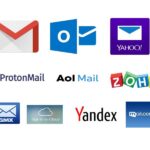Get Private Email
- Home
- Get Private Email

How to Get a Private Email
In an era where privacy is a growing concern, using a private email service can help safeguard your personal information and communication. Unlike traditional email services that may collect and use your data for advertising and other purposes, private email services prioritize security and anonymity. In this guide, we’ll explore how to get a private email account, the benefits of using private email, and tips on maintaining privacy in your online communications.
1. Why Choose a Private Email?
A private email service is designed to protect your privacy and offer greater control over your communications. Here are some key reasons why you might want to choose a private email over standard providers like Gmail or Yahoo:
- Enhanced Security: Private email services often offer end-to-end encryption, meaning only you and the recipient can read the messages.
- Data Privacy: Many private email providers do not collect or share your personal data, reducing the risk of tracking or exploitation for advertising purposes.
- Anonymity: Some private email services allow you to use pseudonyms or anonymous addresses, which can be useful for individuals who want to keep their real identity private.
2. Choose a Private Email Service
There are several private email providers available today, each offering different features to ensure your privacy and security. Here are some of the top options:
ProtonMail
ProtonMail is one of the most popular private email services, known for its strong focus on privacy and security. Based in Switzerland, it benefits from strict privacy laws. ProtonMail offers:
- End-to-end encryption
- No personal data required for registration
- Open-source software
- Free and paid plans available
Tutanota
Tutanota is another highly regarded private email provider. It offers a simple user interface along with robust privacy features. Key features include:
- End-to-end encryption
- No ads or tracking
- Open-source platform
- Free and paid options
Mailfence
Mailfence is a secure email service that emphasizes privacy and offers many features for both personal and professional use. Some of its offerings include:
- End-to-end encryption
- Digital signatures and verification
- No ads, tracking, or data mining
- Free and premium plans
Posteo
Posteo is a German-based email service known for its emphasis on privacy and sustainability. Its features include:
- End-to-end encryption
- No data retention
- Offers anonymous registration
- Highly affordable pricing
CounterMail
CounterMail is a secure email service designed for users who want an extra level of privacy. It uses strong encryption and doesn’t track user data. Key features include:
- End-to-end encryption
- Anonymous sign-up (no email required for registration)
- Secure USB key for login (optional)
3. Set Up Your Private Email Account
After selecting a private email provider, you can begin setting up your account. Here’s a step-by-step process for getting started:
Sign Up: Go to the provider’s website and click on the “Sign Up” or “Create Account” button. Many private email providers allow you to sign up without providing a phone number or any personally identifiable information.
Choose a Username: Choose a secure and anonymous username. For enhanced privacy, avoid using your real name or any identifying information.
Set Up Strong Passwords: Use a strong, unique password for your account. A good password should include a mix of upper and lower-case letters, numbers, and symbols. Consider using a password manager to help store and manage your passwords securely.
Enable Two-Factor Authentication (2FA): For added security, enable 2FA on your private email account. This will require you to verify your identity through another method (such as a code sent to your phone) when logging in.
Configure Encryption Settings: Some private email services allow you to manually configure encryption settings. Be sure to turn on end-to-end encryption (when available) to ensure your emails are securely encrypted.
4. Use Encryption and Secure Communication
One of the core features of private email is encryption. There are two types of encryption to consider:
- End-to-End Encryption: This ensures that your emails are encrypted from the moment they leave your inbox until they are decrypted by the recipient. Only the sender and the recipient can read the contents of the email.
- Transport Layer Security (TLS): This protects the email while it is in transit between email servers. While TLS is more common, it is less secure than end-to-end encryption because the email provider could technically decrypt the message.
Most private email providers, like ProtonMail and Tutanota, automatically use end-to-end encryption, but it’s important to check the settings to ensure it’s enabled.
5. Maintain Privacy with Additional Practices
To further protect your privacy, follow these best practices when using private email:
Avoid Linking Personal Accounts: Do not link your private email address to any personal accounts, such as social media or online shopping. This reduces the risk of your private email being tied to your real identity.
Use Encrypted Attachments: If you need to send attachments, consider encrypting them separately using tools like VeraCrypt or 7zip before sending them through email.
Be Wary of Phishing Attempts: Even with a private email service, always be cautious of phishing attempts. Do not open suspicious emails or click on unverified links.
Don’t Use Your Private Email for Unnecessary Subscriptions: Avoid signing up for newsletters or services that don’t require your private email. Keeping your private email strictly for personal or secure communications will reduce exposure.
6. Upgrade Your Plan for More Features
Many private email providers offer both free and paid plans. While free plans typically offer basic features, upgrading to a paid plan can provide additional security, more storage, and enhanced features such as:
- More Storage Space: If you plan to use your private email for larger file transfers or storing sensitive data, you may need additional storage space.
- Custom Domains: Some paid plans allow you to use a custom domain, which is especially useful for business or professional use.
- More Security Features: Paid accounts often come with enhanced encryption, stronger 2FA options, and access to additional privacy tools.
7. Other Private Email Alternatives
In addition to the services mentioned above, you can also consider using anonymous email services like:
- Guerrilla Mail: For temporary, anonymous email addresses, Guerrilla Mail provides a disposable email service.
- Mailinator: Similar to Guerrilla Mail, Mailinator allows you to create temporary email addresses for quick and anonymous communication.
However, these services are typically less secure than dedicated private email providers and should only be used for one-time or low-priority communications.



